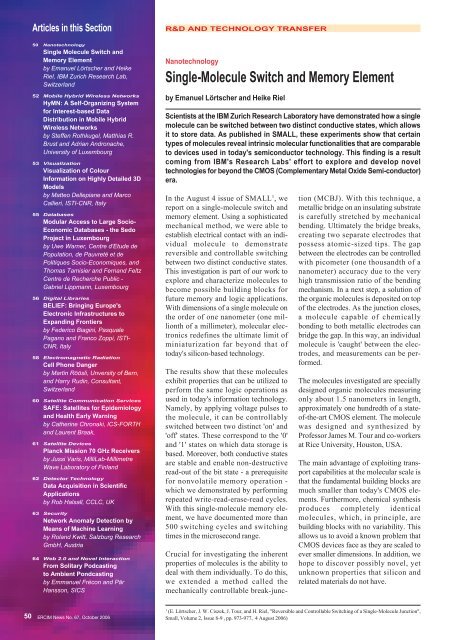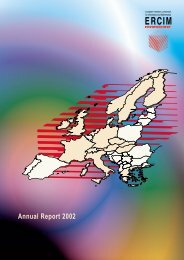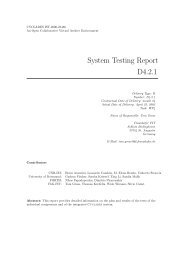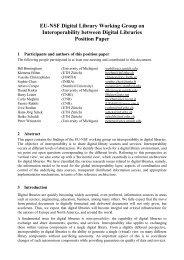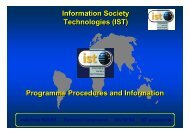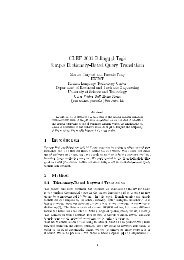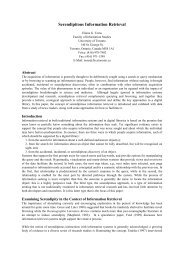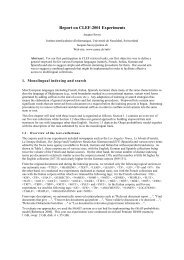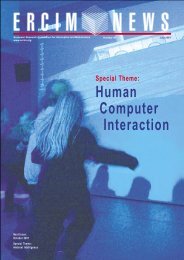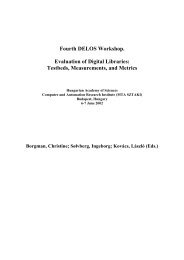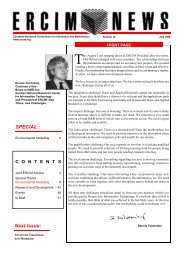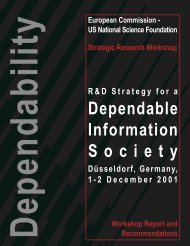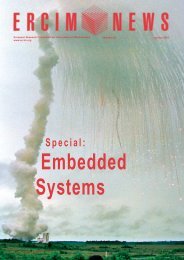Towards a Platform for Widespread Embedded Intelligence - ERCIM
Towards a Platform for Widespread Embedded Intelligence - ERCIM
Towards a Platform for Widespread Embedded Intelligence - ERCIM
Create successful ePaper yourself
Turn your PDF publications into a flip-book with our unique Google optimized e-Paper software.
50<br />
Articles in this Section<br />
50 Nanotechnology<br />
Single Molecule Switch and<br />
Memory Element<br />
by Emanuel Lörtscher and Heike<br />
Riel, IBM Zurich Research Lab,<br />
Switzerland<br />
52 Mobile Hybrid Wireless Networks<br />
HyMN: A Self-Organizing System<br />
<strong>for</strong> Interest-based Data<br />
Distribution in Mobile Hybrid<br />
Wireless Networks<br />
by Steffen Rothkugel, Matthias R.<br />
Brust and Adrian Andronache,<br />
University of Luxembourg<br />
53 Visualization<br />
Visualization of Colour<br />
In<strong>for</strong>mation on Highly Detailed 3D<br />
Models<br />
by Matteo Dellepiane and Marco<br />
Callieri, ISTI-CNR, Italy<br />
55 Databases<br />
Modular Access to Large Socio-<br />
Economic Databases - the Sedo<br />
Project in Luxembourg<br />
by Uwe Warner, Centre d'Etude de<br />
Population, de Pauvreté et de<br />
Politiques Socio-Economiques, and<br />
Thomas Tamisier and Fernand Feltz<br />
Centre de Recherche Public -<br />
Gabriel Lippmann, Luxembourg<br />
56 Digital Libraries<br />
BELIEF: Bringing Europe's<br />
Electronic Infrastructures to<br />
Expanding Frontiers<br />
by Federico Biagini, Pasquale<br />
Pagano and Franco Zoppi, ISTI-<br />
CNR, Italy<br />
58 Electromagnetic Radiation<br />
Cell Phone Danger<br />
by Martin Röösli, Unversity of Bern,<br />
and Harry Rudin, Consultant,<br />
Switzerland<br />
60 Satellite Communication Services<br />
SAFE: Satellites <strong>for</strong> Epidemiology<br />
and Health Early Warning<br />
by Catherine Chronaki, ICS-FORTH<br />
and Laurent Braak,<br />
61 Satellite Devices<br />
Planck Mission 70 GHz Receivers<br />
by Jussi Varis, MilliLab-Millimetre<br />
Wave Laboratory of Finland<br />
62 Detector Technology<br />
Data Acquisition in Scientific<br />
Applications<br />
by Rob Halsall, CCLC, UK<br />
63 Security<br />
Network Anomaly Detection by<br />
Means of Machine Learning<br />
by Roland Kwitt, Salzburg Research<br />
GmbH, Austria<br />
64 Web 2.0 and Novel Interaction<br />
From Solitary Podcasting<br />
to Ambient Pondcasting<br />
by Emmanuel Frécon and Pär<br />
Hansson, SICS<br />
<strong>ERCIM</strong> News No. 67, October 2006<br />
R&D AND TECHNOLOGY TRANSFER<br />
Nanotechnology<br />
Single-Molecule Switch and Memory Element<br />
by Emanuel Lörtscher and Heike Riel<br />
Scientists at the IBM Zurich Research Laboratory have demonstrated how a single<br />
molecule can be switched between two distinct conductive states, which allows<br />
it to store data. As published in SMALL, these experiments show that certain<br />
types of molecules reveal intrinsic molecular functionalities that are comparable<br />
to devices used in today's semiconductor technology. This finding is a result<br />
coming from IBM's Research Labs' ef<strong>for</strong>t to explore and develop novel<br />
technologies <strong>for</strong> beyond the CMOS (Complementary Metal Oxide Semi-conductor)<br />
era.<br />
In the August 4 issue of SMALL 1 , we<br />
report on a single-molecule switch and<br />
memory element. Using a sophisticated<br />
mechanical method, we were able to<br />
establish electrical contact with an individual<br />
molecule to demonstrate<br />
reversible and controllable switching<br />
between two distinct conductive states.<br />
This investigation is part of our work to<br />
explore and characterize molecules to<br />
become possible building blocks <strong>for</strong><br />
future memory and logic applications.<br />
With dimensions of a single molecule on<br />
the order of one nanometer (one millionth<br />
of a millimeter), molecular electronics<br />
redefines the ultimate limit of<br />
miniaturization far beyond that of<br />
today's silicon-based technology.<br />
The results show that these molecules<br />
exhibit properties that can be utilized to<br />
per<strong>for</strong>m the same logic operations as<br />
used in today's in<strong>for</strong>mation technology.<br />
Namely, by applying voltage pulses to<br />
the molecule, it can be controllably<br />
switched between two distinct 'on' and<br />
'off' states. These correspond to the '0'<br />
and '1' states on which data storage is<br />
based. Moreover, both conductive states<br />
are stable and enable non-destructive<br />
read-out of the bit state - a prerequisite<br />
<strong>for</strong> nonvolatile memory operation -<br />
which we demonstrated by per<strong>for</strong>ming<br />
repeated write-read-erase-read cycles.<br />
With this single-molecule memory element,<br />
we have documented more than<br />
500 switching cycles and switching<br />
times in the microsecond range.<br />
Crucial <strong>for</strong> investigating the inherent<br />
properties of molecules is the ability to<br />
deal with them individually. To do this,<br />
we extended a method called the<br />
mechanically controllable break-junc-<br />
tion (MCBJ). With this technique, a<br />
metallic bridge on an insulating substrate<br />
is carefully stretched by mechanical<br />
bending. Ultimately the bridge breaks,<br />
creating two separate electrodes that<br />
possess atomic-sized tips. The gap<br />
between the electrodes can be controlled<br />
with picometer (one thousandth of a<br />
nanometer) accuracy due to the very<br />
high transmission ratio of the bending<br />
mechanism. In a next step, a solution of<br />
the organic molecules is deposited on top<br />
of the electrodes. As the junction closes,<br />
a molecule capable of chemically<br />
bonding to both metallic electrodes can<br />
bridge the gap. In this way, an individual<br />
molecule is 'caught' between the electrodes,<br />
and measurements can be per<strong>for</strong>med.<br />
The molecules investigated are specially<br />
designed organic molecules measuring<br />
only about 1.5 nanometers in length,<br />
approximately one hundredth of a stateof-the-art<br />
CMOS element. The molecule<br />
was designed and synthesized by<br />
Professor James M. Tour and co-workers<br />
at Rice University, Houston, USA.<br />
The main advantage of exploiting transport<br />
capabilities at the molecular scale is<br />
that the fundamental building blocks are<br />
much smaller than today's CMOS elements.<br />
Furthermore, chemical synthesis<br />
produces completely identical<br />
molecules, which, in principle, are<br />
building blocks with no variability. This<br />
allows us to avoid a known problem that<br />
CMOS devices face as they are scaled to<br />
ever smaller dimensions. In addition, we<br />
hope to discover possibly novel, yet<br />
unknown properties that silicon and<br />
related materials do not have.<br />
1 (E. Lörtscher, J. W. Ciszek, J. Tour, and H. Riel, "Reversible and Controllable Switching of a Single-Molecule Junction",<br />
Small, Volume 2, Issue 8-9 , pp. 973-977, 4 August 2006)


